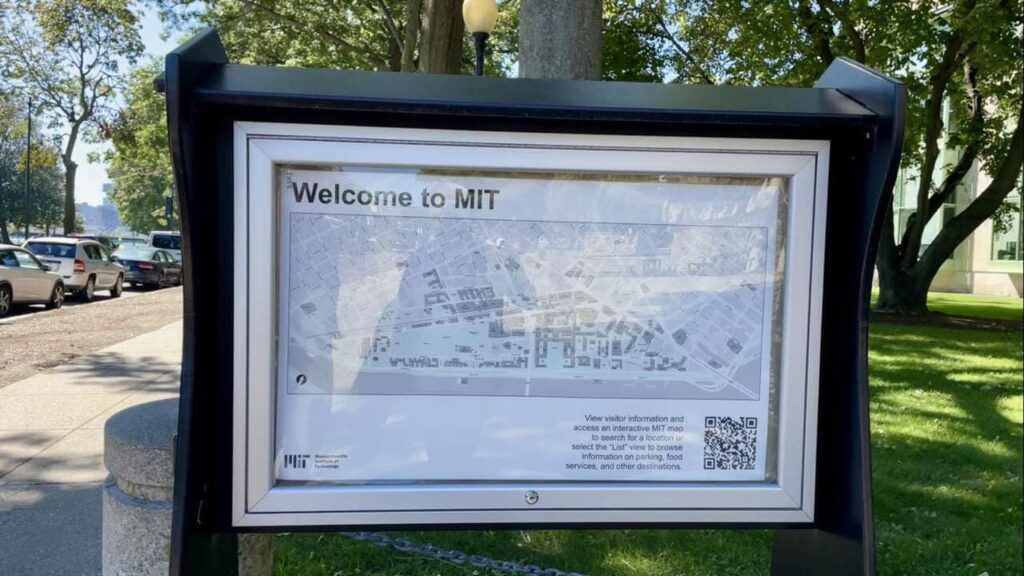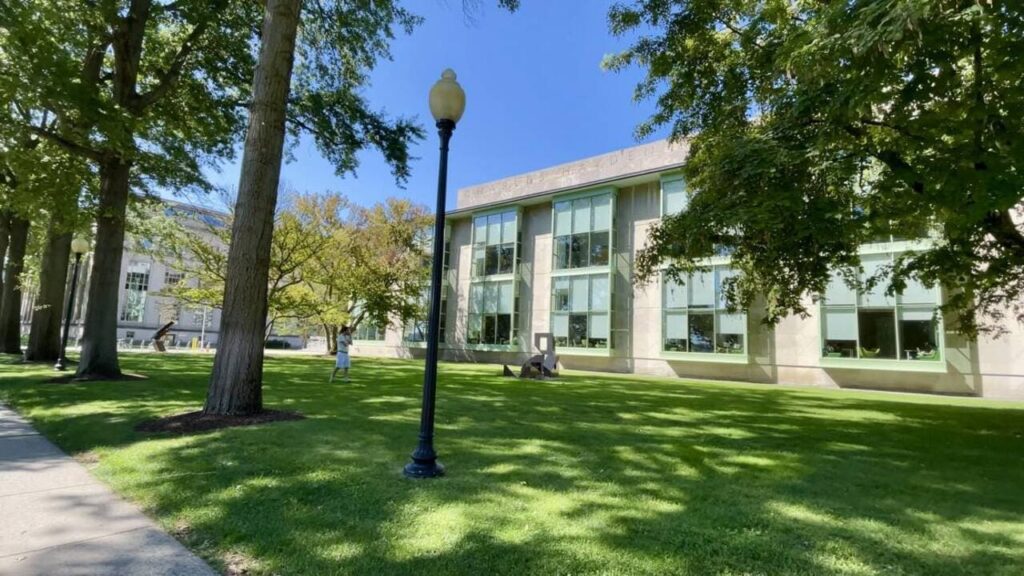The Massachusetts Institute of Technology, commonly known as MIT is a beacon of innovation and academic excellence. It is situated in the heart of Cambridge, Massachusetts, USA. In this blog post, we will let you know how to study at MIT and will also give you a comprehensive guideline.
MIT has forged a legacy of pioneering research, technological advancement, and intellectual rigor. Moreover, renowned worldwide, it consistently ranks among the foremost institutions in engineering, science, and technology. So, many students around the world desire to study at MIT.
Our comprehensive guide will walk you through everything you need to know. From eligibility criteria and scholarships to facilities and the step-by-step admission process. In addition, it will include a detailed look at the diverse range of courses offered by MIT.
How to study at MIT: an overview
Established in 1861, what sets MIT apart is its unwavering commitment to pushing the boundaries of knowledge. The institute boasts a diverse community of brilliant minds, including Nobel laureates, inventors and leading experts across various disciplines.

Moreover, through its cutting-edge laboratories, state-of-the-art facilities and collaborative environment, MIT fosters an atmosphere where bold ideas are not only welcomed but also encouraged!
Why & how to study at MIT?
MIT’s influence extends far beyond its campus, with countless alumni driving innovation across industries, from Silicon Valley to international research institutions.
The institute’s ethos of ‘mens et manus‘ (mind and hand) represents its practical approach to problem-solving academic structure. It ensures that ideas conceived within its borders translate into tangible solutions that benefit society as a whole.
Furthermore, as a crucible of innovation, MIT continues to shape the course of technological progress. These are the reasons why you should study at MIT.
How to study at MIT: exploring MIT’s faculties and courses
MIT has world-class faculties across a spectrum of disciplines. Whether your interests lie in engineering, computer science, humanities or any other field, MIT offers a diverse range of courses led by renowned experts in their respective domains. MIT offers all courses under six schools and colleges under the institute. These are:
- School of Architecture and Planning
- School of Engineering
- School of Humanities, Arts, and Social Sciences
- MIT Sloan School of Management
- School of Science
- MIT Stephen A. Schwarzman College of Computing
We will explain them now a little bit more. Let’s check them out.
1. School of Architecture and Planning
The School of Architecture and Planning (SA+P) has supported MIT’s mission of meeting the world’s greatest challenges since its start in 1865. While advocating the forward-looking, technologically driven optimism of MIT, the School also invests in critically reflecting on technological innovation—its social impact and confrontation with cultural values.
The School of Architecture and Planning enrolls an average of 600–700 students a year in a collection of courses ranging from Renaissance architecture to the cities of tomorrow, digital fabrication, motion graphics, shape grammars, photography, sensor systems, integrative design across disciplines, news and participatory media, and construction finance.
By far the largest number of those students enter the graduate programs, and many pursue cross-disciplinary studies and dual degrees among those programs and others at the Institute.
2. School of Engineering
Since its establishment in 1861, engineering education has remained central to the Institute’s mission. MIT, in its pioneering efforts, devised a contemporary model for engineering education, firmly rooted in a constantly evolving foundation of science. This groundbreaking approach gave rise to the modern research university, marked by externally funded research initiatives and a network of academic departments and research facilities collaborating across diverse fields.
Furthermore, MIT played a pivotal role in the inception of entirely novel fields, including chemical engineering, sanitary engineering, naval architecture, and marine engineering, as well as soil mechanics. Additionally, the Institute introduced the inaugural course in aeronautical engineering.
More recently, MIT has opened up fresh avenues for students to delve into concentrations in expansive, interdisciplinary domains like computing, energy, medical science and engineering, robotics, computational engineering, and poverty alleviation.
3. School of Humanities, Arts, and Social Sciences
MIT’s mission to address global challenges necessitates not only exceptional technical and scientific creativity but also a profound comprehension of the intricate human dimensions—cultural, political, and economic—within which these challenges exist.
Within MIT’s School of Humanities, Arts, and Social Sciences (SHASS), various disciplines empower young students, thinkers, and citizens by providing them with historical and cultural perspectives, as well as language proficiency, critical thinking abilities, and effective communication skills. These capacities are instrumental in undertaking projects imbued with depth and sagacity.
Comprising 11 units, the school encompasses Anthropology, Comparative Media Studies/Writing, Economics, Global Languages, History, Linguistics and Philosophy, Literature, Music and Theater Arts, Political Science, Science, Technology, and Society, and Women’s and Gender Studies.
4. MIT Sloan School of Management
At MIT Sloan, astute and self-reliant leaders converge, united in the belief that the world can and should progress. So, this belief is translated into action and influence through MIT Sloan’s transformative process, converting confidence into capability, and directing unwavering determination and ambition towards audacious endeavors.
Similarly, the array of programs at MIT Sloan is diverse, catering to a wide audience, spanning from undergraduates to seasoned executives. MIT’s comprehensive portfolio includes programs like the Master of Finance and Master of Analytics, tailored for recent graduates.

Additionally, there’s the flagship two-year MBA and the intensive MIT Sloan Fellows MBA Program, spanning a year. These offerings aim to equip leaders with the skills and knowledge needed to address complex business challenges and make contributions towards global betterment.
5. School of Science
The School of Science is an amazing enterprise with approximately 275 faculty members, 1,200 graduate students, 800 undergraduate majors, and comparable numbers of postdoctoral researchers and research staff, the school is large enough to carry out research at the frontiers in every field of science. Additionally, MIT provides each of its undergraduates with an understanding of the basic elements of biology, chemistry, mathematics, and physics.
However, there are many departments and research institutes under the School of Science. For example, the Department of Earth and Planetary Sciences, the Department of Brain and Cognitive Sciences, McGovern Institute for Brain Research, and the Picower Institute for Learning and Memory.
6. MIT Stephen A. Schwarzman College of Computing
Advancements in computing are poised to shape the next chapter of human history significantly. Hence, This transformation is especially evident in the evolution of artificial intelligence (AI) systems, which enhance or supplant human decision-making and logic.
During this pivotal juncture, the MIT Stephen A. Schwarzman College of Computing is dedicated to tackling the prospects and hurdles presented by the computing era. These encompass a spectrum, ranging from hardware and software to algorithms and artificial intelligence.
How to study at MIT, which departments and courses are there?
MIT offers lots of courses in its schools and departments. So, students have the opportunity to choose the courses that best match them. Here is the list of departments and courses is given below for you:
- Aeronautics and Astronautics
- Anthropology
- Architecture
- Biological Engineering
- Biology
- Brain and Cognitive Sciences
- Chemical Engineering
- Chemistry
- Civil and Environmental Engineering
- Comparative Media Studies/Writing
- Data, Systems, and Society
- Earth, Atmospheric, and Planetary Sciences
- Economics
- Electrical Engineering and Computer Science
- Global Languages
- Health Sciences and Technology
- History
- Humanities
- Linguistics and Philosophy
- Literature
- Management
- Materials Science and Engineering
- Mathematics
- Mechanical Engineering
- Media Arts and Sciences
- Music and Theater Arts
- Nuclear Science and Engineering
- Physics
- Political Science
- Science, Technology, and Society
- Urban Studies and Planning
Tuition fees to study at MIT
Studying at MIT is a prestigious opportunity. However, tuition fees can be a concern for many aspiring students. Tuition fees at MIT really depend on courses.
In 2019–2020, undergraduate students paid $53,790 for nine months of tuition and fees. About 59% of students received need-based MIT scholarships. Graduate students also paid $53,790 for nine months of tuition and $17,800 for summer.
Nevertheless, individual departments mostly fund financial support for graduate students, offering fellowships, traineeships, teaching and research assistantships, and loans. The yearly rise in costs has sparked a humorous tradition among students, known as “tuition riots,” which has been around since the 1960s.
If you would like to know the tuition fees for the 2023-2024 session, please check this document.
Life at MIT
Life at MIT begins with a whirlwind of innovation. Consequently, students immerse themselves in relentless academic pursuits. Furthermore, the campus buzzes with collaborative energy, fostering groundbreaking research. Meanwhile, extracurriculars offer a balance, ensuring holistic growth at the same time. Therefore, MIT not only shapes brilliant minds but also cultivates dynamic personalities.

Residential life
MIT offers a range of housing options, fostering a vibrant and inclusive community for students. By living on campus, you can fully immerse yourself in the MIT experience and forge lasting friendships.
Moreover, the residential experience at MIT is meticulously designed to cultivate a sense of community and offer students a supportive and enriching living environment. With a spectrum of options available, including dormitories and independent living groups, there’s a choice to cater to various preferences.
Student organizations and activities
Engage with the diverse array of student organizations and activities available at MIT. Whether your interests lie in cultural clubs, academic societies, or entrepreneurial ventures, there’s a niche for everyone.
With over 500 student groups spanning a broad spectrum of interests, MIT’s campus buzzes with activity. Participating in extracurricular activities not only allows you to meet like-minded peers but also fosters the development of leadership skills while making a positive impact on campus.
Support Services
MIT actively offers a diverse range of support services, encompassing academic advising, health and wellness resources, as well as career guidance. These services aim to foster your academic and personal growth.
Furthermore, MIT wholeheartedly commits to ensuring the success and well-being of its students. You’ll find an abundance of resources ready to assist you with academic planning, personal challenges, and career development, providing continuous support throughout your journey at MIT.
How to study at MIT? Eligibility & requirements explained
Before you dive into the application process, it’s important to ensure you meet MIT’s eligibility criteria. To be considered for admission, you must have a strong academic record and demonstrate a passion for your chosen field of study. Additionally, MIT requires the SAT or the ACT for both prospective first-year and transfer students.
However, for non-native English speakers, we strongly recommend providing the results of an English proficiency exam. For example:
- Cambridge English Qualifications (C1 Advanced or C2 Proficiency)
- Duolingo English Test (DET)
- IELTS (International English Language Testing System)
- Pearson Test of English (PTE) Academic
- TOEFL (Test of English as a Foreign Language)
How to study at MIT: application process
There are six main steps you need to follow to submit your MIT application. Below are the steps, numbered in the rough order you should complete them.
Step 1: Create a MyMIT account and start your application
Firstly, you just need to create a MyMIT account through the MIT application portal. Creating an account only takes a few minutes, and once you do this you’ll be able to complete an application, track the pieces of the application you’ve submitted, join the MIT mailing list, and get your interviewer’s name and contact information.
To create an account you’ll have to fill out some basic demographic information such as your birth date, high school name, and home address.

Step 2: complete the online application
The bulk of the MIT application centers around completing it online. Once you log in to the MIT account you created, you’ll be prompted to fill out all of the requested information. This process initiates with providing biographical information, specifying the application deadline you’ve chosen, and detailing your academic history and test scores.
Subsequently, you’ll round out your application by furnishing details about your activities, employment, and awards, in addition to composing three short essay responses.
Family information
Initiating the application should be a relatively swift process, taking approximately 30 minutes to complete. Firstly, you’ll specify whether you’re applying through early action or regular action. Following this, you’ll provide details about your parents’ occupations and their highest level of education. If you have siblings attending college, you’ll share where they are enrolled, if applicable. Additionally, you’ll list all the high schools you’ve attended, along with various other pertinent information.
Additional information
While this section primarily involves selecting options from drop-down boxes and filling in blanks, it’s worth noting that there are also a few short answer questions to address. These questions prompt you to reflect on how your cultural experiences have influenced your aspirations and to articulate why your chosen field of study holds appeal, for instance.
Extracurriculars
After that, you’ll move on to the part of the application where you really get to shine. You’ll get to enter information about all the extracurriculars and jobs you’ve participated in, advanced classes you’ve taken, awards you’ve won, and your exam scores.
Academic information
You’ll also self-report all the classes you’ve taken and the grades you got in them although, again, you’ll still need to submit your official transcript. Once you’ve entered information about your academics and extracurriculars, you’ll get to respond to MIT’s short response essay questions.
Essay writing
Unlike many other schools, MIT doesn’t require one long essay; instead, you’ll answer three short prompts. Here are the essay prompts, along with the word count requirement:
- We know you lead a busy life, full of activities, many of which are required of you. Tell us about something you do simply for the pleasure of it. (200-250 words)
- Describe the world you come from (for example, your family, school, community, city, or town). How has that world shaped your dreams and aspirations? (200-250 words)
- MIT brings people with diverse backgrounds and experiences together to better the lives of others. Our students work to improve their communities in different ways, from tackling the world’s biggest challenges to being good friends. Describe one way you have collaborated with people who are different from you to contribute to your community. (200-250 words)
- Tell us about a significant challenge you’ve faced (that you feel comfortable sharing) or something that didn’t go according to plan. How did you manage the situation? (200-250 words)
Finally, you’ll enter the information about the two teachers who are writing evaluations for you (see Step 5 for more info) and submit any supplemental materials (see Step 6 for more info).
After you’ve finished each of these sections and reviewed them, you can submit them. Finally, you’ll be prompted to pay the $75 MIT application fee.
Step 3: Submit your secondary school report and Standardized Test Scores
You’ll need to send your official high school transcript to MIT. MIT once again requires SAT or ACT scores from all applicants. You’ll need to have official score reports sent to MIT. You can learn exactly how to send SAT scores and ACT scores in our in-depth guides.
Step 4: ask two teachers to fill out your evaluations
You’ll need two letters of recommendation for MIT, one from a math/science teacher and one from a humanities/language teacher. In your MIT Application account, you’ll fill out each of your recommender’s names and email addresses so the form can be sent to them. Your recommendations are due the same day as the rest of your application.
Step 5: set up and complete an interview
While interviews are not technically obligatory, MIT places a high emphasis on them and admits very few applicants who did not undergo an interview. Therefore, if possible, it is strongly advised that you schedule one.
Following the submission of your application, an Educational Counselor (EC) will reach out to you. The EC, an MIT alum, will be responsible for conducting your interview. It’s worth noting that there are over 5,000 ECs situated around the world, ensuring accessibility for applicants in various locations.

You and your EC will either meet virtually or set up an interview at a place near you. Most early action interviews take place in November, and most regular action interviews take place in January. In non-COVID times, the interview typically lasts an hour and often takes place in a location such as a coffee shop, restaurant or library.
Some may also take place over Skype or otherwise virtually. MIT recommends thinking about questions you might be asked before the interview, and here are 14 of the most common college interview questions.
Step 6: (optional) Submit supplementary materials
Generally, you also have the option to submit supplementary materials. This is a completely optional step and is typically done by students with a fine arts or music portfolio, those with research experience, and/or those who hope to play a varsity sport for MIT. There are five different kinds of supplemental materials you can send.
You can find more information about each of these options on the MIT Admissions Blog. If you choose to complete any of these materials, you’ll submit them separately from the rest of your application.
How to study at MIT with scholarships
Generally, MIT’s scholarships are exclusively granted based on financial need. The funds come from MIT’s endowment, contributions from MIT alumni and supporters, as well as general MIT funds. However, to get a scholarship you need to fulfill some criteria. You can easily find more information and updated details on scholarships at MIT by visiting the official MIT website and searching for their financial aid and scholarship pages. Here’s how you can find these scholarships:
- MIT Presidential Scholarship: You can find more information about the MIT Presidential Scholarship on MIT’s financial aid website. Visit MIT Financial Aid for details.
- MIT Burchard Scholars Program: To learn about the MIT Burchard Scholars Program and its application process, visit the MIT Burchard Scholars Program page.
- MIT Scholarships for International Students: For information on scholarships available to international students at MIT, visit the MIT International Students Financial Aid page.
- MIT Priscilla King Gray Public Service Center Fellowships: To explore the various fellowships offered by the Priscilla King Gray Public Service Center at MIT, visit their official Fellowships and Internships page.
- MIT Society of Women Engineers (SWE) Scholarships: For information on scholarships for women in STEM fields, you can visit the MIT SWE Scholarships page.
- MIT Sloan Fellowships: To learn about the various fellowships available for MBA and graduate business programs at MIT Sloan School of Management, visit the MIT Sloan Fellowships page.
However, remember that scholarship details and availability may change over time. That’s why it’s essential to visit MIT’s official financial aid website or contact the MIT Financial Aid Office directly for the most up-to-date information on scholarships and financial aid opportunities.
How to study at MIT (FAQs)
What programs and degrees does MIT offer?
MIT offers a wide range of undergraduate, graduate, and doctoral programs across various fields of study. These include engineering, computer science, physical sciences, social sciences, humanities, and more. Additionally, MIT is known for its cutting-edge research opportunities.
How competitive is the admission process at MIT?
Admission to MIT is highly competitive. The institute seeks students who have demonstrated exceptional academic abilities, a strong passion for their chosen field, and a desire to make a positive impact on the world. Applicants are evaluated based on their academic records, standardized test scores, recommendation letters, extracurricular activities, and essays.
What is the financial aid and scholarship availability for MIT students?
MIT is committed to making education accessible to all students, regardless of financial circumstances. The institute provides need-based financial aid and a variety of scholarships and grants. MIT also meets the full demonstrated need of admitted students, ensuring that financial barriers do not prevent talented students from attending.
How to study at MIT for free?
MIT guarantees that students from families with incomes below $140,000 (plus typical assets) will receive enough scholarship support to attend the institution without having to pay tuition. Around 58% of undergraduates at MIT get MIT Scholarships. In the 2021-2022 academic year, the typical MIT Scholarship was $53,997. Please check the scholarships at MIT section of this blog to have more info on how to study at MIT for free.
Closing statements
Studying at MIT is a transformative experience that opens doors to a world of innovation and knowledge. By following this A-Z guide, you’ll be well-prepared to navigate the admissions process and embark on your academic journey at one of the world’s premier institutions. However, remember that MIT is not just a university; it’s a community of thinkers, creators, and leaders who are shaping the future. Good luck, and welcome to MIT!
